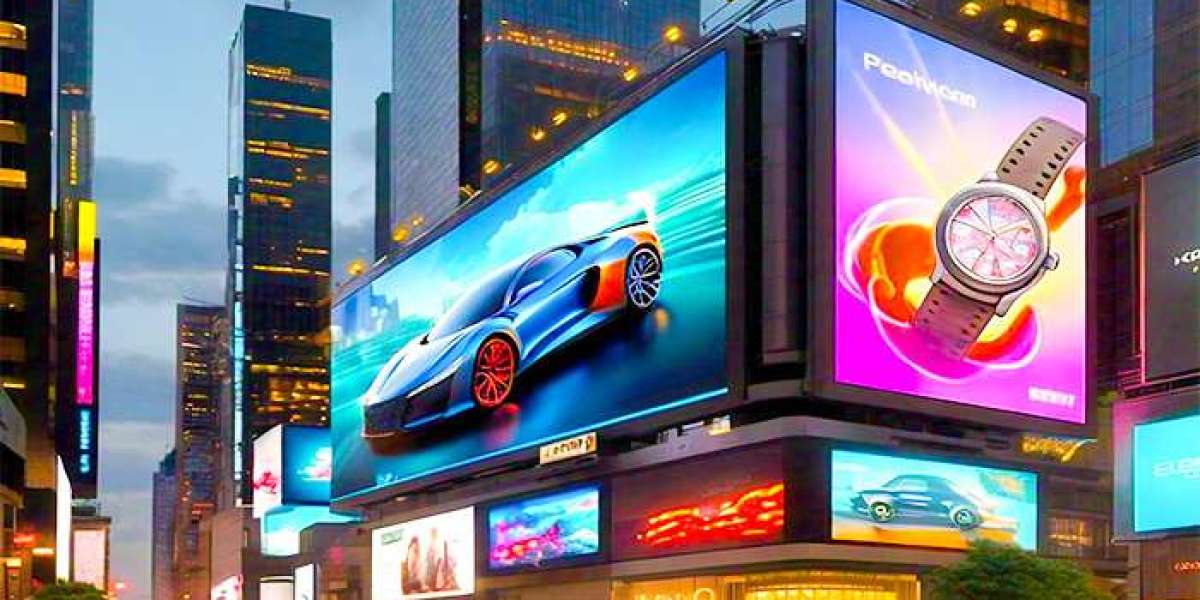Introduction
Have you ever walked down a bustling street, your eyes drawn to a vibrant, dynamic advertisement displayed on a sleek, glowing screen? That’s the magic of SMD screen display advertisements. These cutting-edge screens are revolutionizing the advertising world, offering unparalleled brightness, flexibility, and engagement. Let’s dive into the world of SMD screens and explore why they are becoming the go-to choice for advertisers everywhere.
What is an SMD Screen?
Definition and Explanation
SMD stands for Surface-Mounted Device. In the context of screens, it refers to LEDs (Light Emitting Diodes) that are mounted directly onto the surface of a printed circuit board. This technology allows for the creation of high-resolution, vibrant displays that can showcase stunning visuals and videos.
Types of SMD Screens
There are various types of SMD screens, categorized mainly by their pixel pitch (the distance between the centers of two adjacent pixels). Smaller pixel pitches mean higher resolution, making them ideal for closer viewing distances. Common types include:
- Indoor SMD Screens: Typically have a smaller pixel pitch for high-definition indoor displays.
- Outdoor SMD Screens: Designed to withstand weather conditions with a larger pixel pitch for visibility from greater distances.
The Technology Behind SMD Screens
How SMD Screens Work
SMD screens utilize tiny LEDs that emit light when an electric current passes through them. These LEDs are arranged in a grid pattern, allowing them to create images and videos by varying the intensity and color of each pixel. The result is a bright, high-contrast display that can be viewed from various angles and distances.
Advantages of SMD Technology
- Brightness: SMD screens are exceptionally bright, making them perfect for outdoor use even in direct sunlight.
- Energy Efficiency: These screens consume less power compared to traditional display technologies.
- Durability: SMD screens are built to last, with robust components that can withstand harsh environmental conditions.
Benefits of Using SMD Screens in Advertising
High Visibility and Brightness
One of the primary advantages of SMD screens is their exceptional brightness and visibility. This makes them ideal for capturing the attention of passersby, even in well-lit environments.
Versatility and Flexibility
SMD screens are highly versatile. They can be used in various settings, from retail stores and shopping malls to outdoor billboards and transportation hubs. Their flexibility allows advertisers to create dynamic content that can be easily updated and customized.
Energy Efficiency
SMD screens are designed to be energy-efficient, reducing operational costs while still providing high-quality displays. This makes them an eco-friendly option for businesses looking to minimize their carbon footprint.
Applications of SMD Screen Display Advertisement
Retail and Shopping Malls
In retail environments, SMD screens are used to showcase products, promotions, and brand messages. Their vibrant displays attract customers and enhance the shopping experience.
Outdoor Billboards
SMD screens are a popular choice for outdoor billboards due to their brightness and durability. They can display advertisements that are visible from long distances, even in adverse weather conditions.
Events and Exhibitions
At events and exhibitions, SMD screens are used to create immersive experiences. They can display real-time information, promotional videos, and interactive content, engaging attendees and enhancing brand presence.
Transportation Hubs
In airports, train stations, and bus terminals, SMD screens provide passengers with vital information, such as schedules and announcements. They also serve as advertising platforms, reaching a large and diverse audience.
Designing Effective SMD Screen Advertisements
Key Elements of a Great Ad
Creating an effective SMD screen advertisement involves several key elements:
- Clear Message: The message should be concise and easy to understand.
- Compelling Visuals: High-quality images and videos grab attention and convey the message effectively.
- Call to Action: Encourage viewers to take action, whether it’s visiting a website, making a purchase, or attending an event.
Visual and Textual Balance
Balance is crucial in SMD screen ads. Too much text can overwhelm viewers, while excessive visuals can dilute the message. A harmonious balance ensures that the ad is both engaging and informative.
Color Theory and Impact
Colors play a significant role in the effectiveness of an advertisement. Bright, contrasting colors can capture attention, while more subdued tones can convey sophistication and elegance. Understanding color theory helps in creating visually appealing and impactful ads.
Case Studies: Successful SMD Screen Campaigns
Real-World Examples
Several brands have successfully leveraged SMD screens to enhance their advertising campaigns. For example, Coca-Cola’s dynamic outdoor billboards have captivated audiences with their vibrant visuals and interactive features. Similarly, Nike’s use of SMD screens in retail stores has created immersive shopping experiences that boost customer engagement.
Lessons Learned
From these successful campaigns, we learn that creativity, clarity, and audience engagement are key to maximizing the impact of SMD screen advertisements. Tailoring content to the target audience and leveraging the unique features of SMD technology can lead to impressive results.
Choosing the Right SMD Screen for Your Needs
Factors to Consider
When selecting an SMD screen for advertising, consider factors such as:
- Pixel Pitch: Determine the appropriate resolution based on viewing distance.
- Brightness: Ensure the screen is bright enough for the intended environment.
- Size and Shape: Choose a screen that fits the available space and meets your advertising needs.
Comparing Different Models
Compare different SMD screen models by evaluating their specifications, performance, and cost. Reading reviews and consulting with experts can help you make an informed decision.
Installation and Maintenance of SMD Screens
Best Practices for Installation
Proper installation is crucial for the optimal performance of SMD screens. Hire professionals to ensure the screen is securely mounted and correctly configured. Consider factors such as viewing angles, ambient lighting, and accessibility for maintenance.
Regular Maintenance Tips
Regular maintenance extends the lifespan of SMD screens. Clean the screens periodically to remove dust and debris, check for any technical issues, and perform necessary repairs promptly.
Cost Considerations
Initial Investment
The initial cost of SMD screens can be high, but it’s an investment that pays off in the long run. High-quality screens provide excellent durability and performance, reducing the need for frequent replacements.
Long-Term Savings
Despite the initial investment, SMD screens offer long-term savings due to their energy efficiency and low maintenance requirements. Businesses can save on operational costs while enjoying the benefits of high-quality displays.
Future Trends in SMD Screen Display Advertisement
Technological Advancements
The future of SMD screen technology looks promising, with ongoing advancements in resolution, brightness, and interactivity. Emerging technologies like flexible screens and AI-driven content customization are set to revolutionize the advertising landscape.
Market Growth Predictions
The demand for SMD screens is expected to grow significantly in the coming years, driven by their versatility and effectiveness. Businesses across various industries are likely to adopt this technology to enhance their advertising strategies.
Challenges and Solutions in SMD Advertising
Common Issues
While SMD screens offer numerous benefits, they also come with challenges such as high initial costs, technical complexities, and potential visibility issues in extreme weather conditions.
Effective Solutions
Address these challenges by investing in high-quality screens, providing proper training for technical staff, and implementing protective measures for outdoor installations. Regular maintenance and updates also help in mitigating potential issues.
Environmental Impact of SMD Screens
Eco-Friendly Features
SMD screens are designed with eco-friendly features, including energy-efficient LEDs and recyclable materials. This reduces their environmental impact and supports sustainability efforts.
Sustainability Practices
Adopting sustainable practices, such as using renewable energy sources and minimizing electronic waste, further enhances the eco-friendliness of SMD screen advertisements. Businesses can promote their commitment to sustainability through responsible advertising practices.
Conclusion
SMD screen display advertisement is transforming the way businesses connect with their audiences. With their high visibility, versatility, and energy efficiency, SMD screens are an invaluable tool for modern advertising. As technology continues to advance, we can expect even more innovative and impactful uses of SMD screens in the future.
FAQs
What is the lifespan of an SMD screen?
The lifespan of an SMD screen varies depending on the quality of the components and the conditions of use. On average, SMD screens can last between 50,000 to 100,000 hours with proper maintenance.
How do SMD screens compare to traditional billboards?
SMD screens offer several advantages over traditional billboards, including higher brightness, dynamic content capabilities, and energy efficiency. They can display videos and animations, making them more engaging than static billboards.
Can SMD screens be used indoors and outdoors?
Yes, SMD screens are versatile and can be used both indoors and outdoors. Indoor screens typically have a smaller pixel pitch for high-resolution displays, while outdoor screens are designed to be weather-resistant and visible from long distances.
What are the maintenance requirements for SMD screens?
Regular maintenance for SMD screens includes cleaning the surface to remove dust and debris, checking for any technical issues, and performing necessary repairs. It’s important to follow the manufacturer’s guidelines for maintenance to ensure optimal performance.
Are SMD screens cost-effective for small businesses?
While the initial investment in SMD screens can be high, they offer long-term savings due to their energy efficiency and low maintenance costs. Small businesses can benefit from the enhanced visibility and engagement that SMD screens provide, making them a worthwhile investment.







